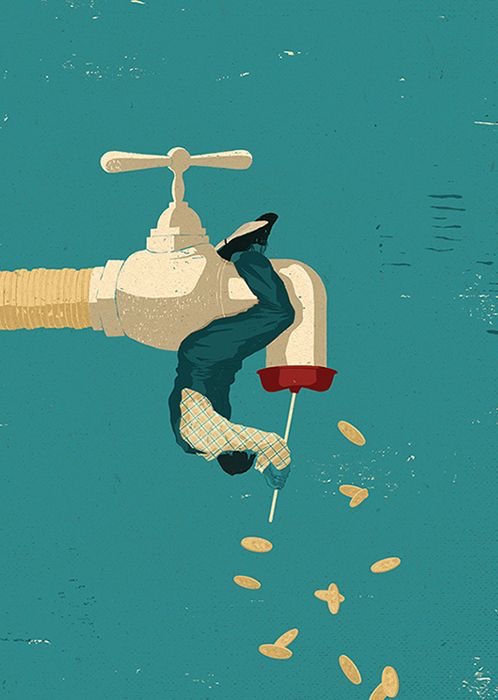Don't let unconscious biases shape your perception of value. Embrace your worth and own your identity!

Understand the power of how you frame your thinking. Our unconscious biases can shape our perception of value and ultimately, our self-worth 💭
The framing effect affects how we form our perceptions of value, therefore, our unconscious biases often influence our sense of self-worth.
A bottle of water can be $1 at the market, $3 at a restaurant, $4 at the movies and $6 at an airport. It's the same water. Changing the place only changed its value perception.
Is this theory simply a case of the wrong mind in the right place?
In order to determine how much we are willing to pay for objects and services, we need to take into account many factors that influence how we perceive value. There is much more of this going on unconsciously than we realize.
The framing effect has a significant impact on our willingness to pay variable pricing options, as it describes how people make decisions based on the way they frame different possibilities.
It is made up of several components: the mere exposure effect, the priming effect, distinction bias, the bottom-dollar effect, accounting bias, sunk cost fallacy, mental accounting, decision fatigue, ambiguity effect, extrinsic incentive, less-is-better effect, naive allocation, zero-risk bias, decisions, influence, and shortcuts.
Those components all contribute to our willingness to pay variable pricing options and affect our perception of value.
The framing effect is a psychological concept that demonstrates how important factors like our emotion, desires, and familiarity with an option can have a strong influence on how we view value and the decisions we make when exercising choices.
So, the next time you feel worthless, maybe you're not in the wrong place. Despite this, there are many other factors influencing your perception of your own value.
In order to determine how much we are willing to pay for objects and services, we need to take into account many factors that influence how we perceive value. There is much more of this going on unconsciously than we realize.
The framing effect is a psychological concept that examines how people make decisions based on the way they frame different possibilities. It has a significant impact on our willingness to pay variable pricing options and how we perceive value and make decisions.
The mere exposure effect is one of the key components of the framing effect; it is the tendency for people to be naturally drawn to familiar things. This contributes to our willingness to pay variable pricing options, as these options have already been defined, or framed, in a way we are familiar with.
The priming effect is another important part of the framing effect. This is when our current mental state affects our behavior, so that decisions we make today are influenced by our emotions and desires of the present moment. This contributes to our willingness to pay variable pricing options, as our immediate needs and desires are taken into account when making the decision.
The distinction bias is another factor in the framing effect that affects our willingness to pay variable pricing options. This is when we feel a greater sense of value when we pay a higher price for something. This is due to the perceived difference between two items of the same quality that cost different amounts.
The bottom-dollar effect is another factor in the framing effect that affects our willingness to pay variable pricing options. This is when we are more willing to pay a higher price for something if it is the last option available.
The accounting bias, sunk cost fallacy, mental accounting and decision fatigue are also factors that contribute to our willingness to pay variable pricing options. The accounting bias is when we think of our options from a financial perspective and make decisions based on short-term financial gain. The sunk cost fallacy is when we continue to invest in something simply because we have already made a financial investment, regardless of the return. Mental accounting is when we group our financial decisions into different ‘accounts’, and apply different criteria when making decisions from different ‘accounts’. Decision fatigue is when our decision making ability decreases as the day goes on and affects our ability to make rational decisions.
The ambiguity effect, extrinsic incentive, less-is-better effect, naive allocation, zero-risk bias, decisions, influence and shortcuts are all factors that also contribute to our willingness to pay variable pricing options. The ambiguity effect is when we are more likely to make decisions when more information is available. The extrinsic incentive is when we perform a task due to an external reward. The less-is-better effect is when we associate a smaller amount of something with quality. The naive allocation is when we make decisions intuitively, instead of rationally. The zero-risk bias is when we choose options with no risk, even if this option has a lower reward. Decisions are when we choose one option over another based on our emotions. Influence is when our decisions are influenced by other people’s opinions. Shortcuts are when we use simplified criteria to make decisions quickly.
There are a lot of things that play a role in our value perception - like our emotions and desires, and it can make us think things are worth more or less. It helps us understand the importance of all the things that influence our decisions.
So, the next time you feel worthless, maybe you're not in the wrong place. Despite this, there are many other factors influencing your perception of your own value.
In conclusion, the framing effect has a profound influence on our willingness to pay variable pricing options and our perception of value. Various components of the framing effect, such as the mere exposure effect, priming effect, distinction bias, bottom-dollar effect, accounting bias, sunk cost fallacy, mental accounting, decision fatigue, ambiguity effect, extrinsic incentive, less-is-better effect, naive allocation, zero-risk bias, decisions, influence and shortcuts all contribute to our willingness to pay variable pricing options.
Be mindful of your biases and take a moment to appreciate your true worth. The framing effect often makes it hard to see our own value, but you are worth much more than you know. 💙 #SetYourselfFree


